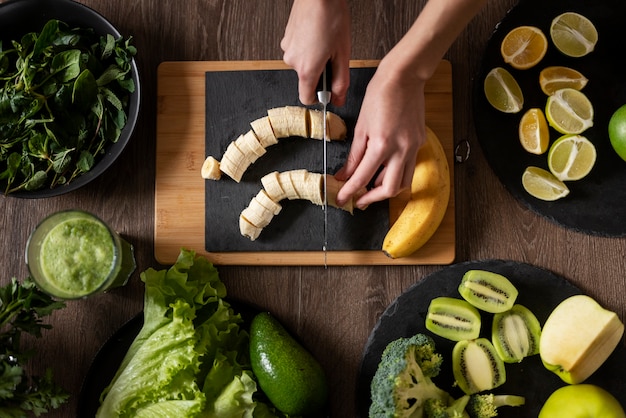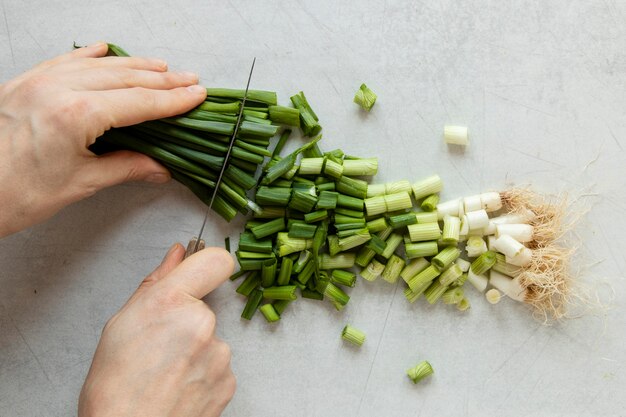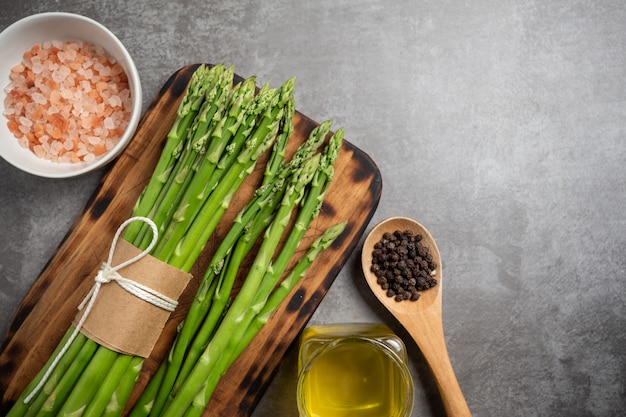(Part 1) The Art of asparagus selection

Tip 1: Look for Vibrant Green
A good asparagus should be a lovely shade of green, not yellow or brown. Those colours indicate that the asparagus has been sitting around a bit too long and may not be as fresh and flavourful. fresh asparagus should be a lively, almost emerald green, a sign of its recent harvest. Avoid any asparagus that has a dull or faded colour.
Tip 2: Check the Tips
The tips of the asparagus should be firm and closed, not open and drooping. This is a sign of freshness. Those tightly closed tips indicate the asparagus hasn't lost its moisture and will be full of flavour. If the tips are open and floppy, it might be a bit past its prime.
Tip 3: Give 'em a Squeeze
Don't be afraid to give those asparagus spears a gentle squeeze. They should be firm to the touch, not floppy. If they're too soft, it means they've been around the block a few times, and their flavour might be a bit lacklustre. The spears should spring back slightly when you press them, indicating their freshness and crispness.
Tip 4: Consider the Size
If you're looking for a quick and easy meal, thinner asparagus spears are a good choice as they cook faster. However, if you prefer a more robust flavour and a slightly more tender texture, go for thicker spears.
Tip 5: The Smell Test
Fresh asparagus has a unique, slightly earthy aroma, almost sweet. If it smells like nothing, it might not be as fresh and flavorful as you'd like.
(Part 2) The Trimming Tango

Why Trimming Matters
The bottom inch or two of the asparagus stalk is often tough and woody, and nobody wants to be chewing on that! Trimming ensures that you're only cooking the tender and delicious parts. Think of it as giving your asparagus a spa treatment, getting rid of the rough edges and revealing the best parts within.
The Technique
There are a couple of ways to trim asparagus. Some people like to use a vegetable peeler, but I find that a sharp knife is the most efficient and precise. Simply hold the asparagus spear near the bottom and cut off the tough end, leaving you with the delicate, edible part. Snap the asparagus spear in half – the breaking point will indicate where the woody part ends and the tender part begins. If you're feeling fancy, you can trim the spears into a uniform length, but this is not necessary.
(Part 3) The Cooking Conundrum: How Long Is Too Long?

1. The Thickness of the Asparagus Spears
Thicker spears need a little bit more time to cook through, while thinner spears will cook more quickly. Think of it like baking a cake – a thicker cake needs more time to bake through.
2. Your Cooking Method
Roasting, grilling, and steaming asparagus all require different cooking times. Just like different cooking methods require different temperatures and times for other vegetables, asparagus is no different.
3. Your Desired Texture
Do you prefer your asparagus tender and just slightly crisp, or do you like it a bit softer? The cooking time will vary depending on your preference. Some people love that al dente, crisp asparagus while others prefer it to be slightly softer, almost melting in their mouth.
4. The Freshness of the Asparagus
Asparagus that's been sitting around for a while may need a bit more cooking time to reach the desired tenderness. This is why fresh asparagus is key!
(Part 4) The Pan-Seared Showdown: A culinary adventure
One of my favourite ways to cook asparagus is in a pan. It's quick, easy, and produces beautifully browned, flavourful spears. Here's my fool-proof guide:Step 1: The Prep
Start by heating a tablespoon or two of olive oil in a large skillet over medium-high heat. While the oil is heating, arrange your trimmed asparagus spears in a single layer in the pan.
Step 2: The Sizzle
Once the oil is shimmering, add the asparagus to the pan and cook, turning occasionally, for about 4-5 minutes, or until the spears are tender and lightly browned. Listen for that beautiful sizzle as the asparagus hits the hot oil – it's a sound of deliciousness.
Step 3: The Finishing Touches
Season the asparagus with salt and pepper to taste, and add a squeeze of lemon juice for a touch of brightness. The lemon juice cuts through the richness of the olive oil and brings out the asparagus' natural sweetness. And if you're feeling adventurous, you can sprinkle a little bit of Parmesan cheese or chopped fresh herbs on top.
Tips for Pan-Seared Asparagus:
- Don't overcrowd the pan. If you add too much asparagus at once, it will steam instead of sear, resulting in a less flavorful dish.
- Use a good quality olive oil. It will add flavor to the asparagus and help it to brown beautifully.
- Don't overcook the asparagus. It should be tender but still have a bit of a bite.
- Serve immediately. Asparagus is best enjoyed fresh.
(Part 5) The Roasted Revelation: A Burst of Flavour
roasting asparagus in the oven is another excellent way to bring out its natural sweetness and create a slightly caramelised texture. Here's how I do it:Step 1: The Preheat
Preheat your oven to 400 degrees Fahrenheit (200 degrees Celsius). Line a baking sheet with parchment paper to prevent sticking. Parchment paper is a lifesaver for roasting, making clean up a breeze.
Step 2: The Toss
Toss your trimmed asparagus spears with a little olive oil, salt, and pepper. You can also add other seasonings like garlic powder or paprika. A little garlic powder adds a savory note, while paprika gives a subtle warmth.
Step 3: The Roast
Spread the asparagus in a single layer on the prepared baking sheet and roast for 10-15 minutes, or until tender and slightly browned. The edges of the asparagus will start to caramelize and become slightly crispy. For extra flavour, you can drizzle a little balsamic vinegar over the asparagus during the last few minutes of cooking. The balsamic vinegar adds a touch of sweetness and acidity that complements the asparagus beautifully.
Tips for roasted asparagus:
- Don't over-crowd the baking sheet. This will ensure the asparagus roasts evenly and doesn't steam.
- Use a good quality olive oil. It will enhance the flavour of the asparagus and help it to brown nicely.
- Toss the asparagus halfway through cooking to ensure that it cooks evenly.
- Serve immediately. Roasted asparagus is best enjoyed fresh.
(Part 6) The Steamed Symphony: A Delicate Dance of Flavour
Steaming is a gentle way to cook asparagus, preserving its vibrant colour and delicate flavour. It's perfect for those who prefer their asparagus slightly more tender and less crisp.Step 1: The Steam
Fill a steamer basket with water and bring it to a boil over medium heat. Place your trimmed asparagus spears in the steamer basket and cover. Steam for 5-8 minutes, or until tender.
Step 2: The Finish
Remove the asparagus from the steamer and season with salt, pepper, and a squeeze of lemon juice. You can also add a touch of butter or olive oil to enhance the flavour. The lemon juice brightens the flavour of the asparagus, while butter or olive oil adds a richness and creaminess.
Tips for steamed asparagus:
- Don't overcrowd the steamer basket. This will prevent the asparagus from steaming evenly.
- Use fresh water. This will ensure that the asparagus doesn't pick up any unwanted flavours.
- Don't overcook the asparagus. It should be tender but still have a bit of a bite.
- Serve immediately. Steamed asparagus is best enjoyed fresh.
(Part 7) The Grill-tastic Grilling: A Summery Treat
grilling asparagus is a fantastic way to enjoy it during the warmer months. It adds a smoky char and a delightful crunch.Step 1: The Prep
Preheat your grill to medium heat. Brush the grill grates with a little olive oil to prevent sticking. Make sure your grill grates are clean and lightly oiled to avoid the asparagus sticking and burning.
Step 2: The Grill
Place your trimmed asparagus spears on the grill and cook, turning occasionally, for 4-6 minutes, or until tender and slightly charred. You'll know the asparagus is ready when it's tender and has those beautiful grill marks.
Step 3: The Seasoning
Remove the asparagus from the grill and season with salt, pepper, and a squeeze of lemon juice. You can also add a sprinkle of garlic powder or herbs like oregano or thyme. The smoky char and the fresh herbs combine beautifully to create a truly delicious dish.
Tips for grilled asparagus:
- Don't overcook the asparagus. It should be tender but still have a bit of a bite.
- Turn the asparagus frequently to ensure that it cooks evenly.
- Serve immediately. Grilled asparagus is best enjoyed fresh.
(Part 8) The Cooking Time Guide: A Cheat Sheet for Perfection
To make things even easier, here's a quick guide to asparagus cooking times based on your chosen method. Remember, these are just general guidelines, and the actual cooking time may vary depending on the thickness of your asparagus and your personal preference.| Cooking Method | Thickness | Cooking Time |
|---|---|---|
| Pan-Seared | Thin | 3-4 minutes |
| Medium | 4-5 minutes | |
| Thick | 5-6 minutes | |
| Roasted | Thin | 8-10 minutes |
| Medium | 10-12 minutes | |
| Thick | 12-15 minutes | |
| Steamed | Thin | 4-5 minutes |
| Medium | 5-7 minutes | |
| Thick | 7-9 minutes | |
| Grilled | Thin | 3-4 minutes |
| Medium | 4-6 minutes | |
| Thick | 5-7 minutes |
(Part 9) The Don't-Overcook-It-Club: A Crucial Reminder
Asparagus is a delicate vegetable, and it can easily become overcooked and mushy. The key is to cook it just until tender, with a slight crunch. Overcooked asparagus loses its flavour and becomes sad and limp, so be careful not to cook it too long!The Telltale Signs of Overcooked Asparagus
- The asparagus will be soft and limp
- The colour will fade and become dull
- The flavour will be bland and muted
The Test for Doneness
To test if your asparagus is cooked, gently pierce a spear with a fork. It should be tender but still have a little bit of resistance. If it's too easy to pierce, it's probably overcooked. If you're unsure, err on the side of slightly undercooked. You can always cook it for a bit longer if needed.
(Part 10) The Asparagus Adventure: A Culinary Odyssey
Once you've mastered the art of cooking asparagus perfectly, the possibilities are endless. There are so many delicious ways to enjoy this spring vegetable.Asparagus as a side dish
Asparagus is a fantastic side dish for a variety of main courses, from grilled chicken and fish to roasted vegetables and pasta dishes. It adds a touch of brightness and freshness to any meal.
Asparagus in Salads
Add some crunch and flavour to your salads with roasted or grilled asparagus. The roasted or grilled asparagus adds a smoky char and a delightful crunch to salads.
Asparagus in Soups and Stews
Asparagus can also be used in soups and stews for a touch of sweetness and a vibrant colour. The asparagus adds a delicate sweetness and a beautiful green colour to soups and stews.
Asparagus as a Star
Don't be afraid to let asparagus take centre stage! It's delicious on its own, especially when served with a simple dressing of lemon juice, olive oil, and salt.
(Part 11) The Asparagus FAQs: Your Questions Answered
1. Can I eat asparagus raw?
You absolutely can eat asparagus raw! It has a slightly sweet and grassy flavour, and can be enjoyed in salads, dips, or as a snack. If you're new to eating asparagus raw, you might want to start with the thinner spears, as they are a bit more tender. Raw asparagus is a great way to add a bit of crunch and a fresh, vegetal flavour to your dishes.
2. How do I store asparagus?
To keep your asparagus fresh, store it in the refrigerator in a plastic bag with the ends trimmed and the spears standing upright. You can also wrap the asparagus in a damp paper towel and place it in a plastic bag. Try to use your asparagus within a few days for the best flavour. You can also store asparagus in a cool, dark place, such as a basement or pantry, for a few days.
3. What if I overcook my asparagus?
If you accidentally overcook your asparagus, don't worry! It might not be as crisp and vibrant as you'd like, but it can still be salvaged. You can try tossing it with a little olive oil, lemon juice, and salt and pepper to give it a bit more flavour. It's also a great addition to soups, stews, or pasta sauces. Overcooked asparagus can add a subtle sweetness to soups and stews.
4. Can I freeze asparagus?
Yes, you can freeze asparagus. Blanch the spears for a few minutes before freezing them. To blanch asparagus, place the spears in a pot of boiling water for 2-3 minutes, then transfer them to a bowl of ice water. This will help to preserve their colour and texture. Once the asparagus is cool, drain it and pat it dry. Then, place it in a freezer-safe bag and store it in the freezer. Blanching the asparagus before freezing helps to preserve its colour, texture, and flavour.
5. What are the health benefits of asparagus?
Asparagus is a good source of vitamins, minerals, and antioxidants. It's also low in calories and fat. Some of the health benefits of asparagus include:
- Improved digestion: Asparagus is a good source of fiber, which helps to promote regular bowel movements.
- Reduced risk of heart disease: Asparagus is a good source of potassium, which helps to regulate blood pressure.
- Improved blood sugar control: Asparagus is a good source of fiber and chromium, which can help to regulate blood sugar levels.
- Boosted immune system: Asparagus is a good source of vitamin C, which is an important antioxidant that helps to boost the immune system.
- Anti-inflammatory properties: Asparagus is a good source of antioxidants, which have anti-inflammatory properties.
And there you have it, my friends! The complete guide to cooking asparagus perfectly. Now go forth and conquer the world of asparagus with confidence!
Everyone is watching

Prime Rib Roast Cooking Time Chart: Per Pound Guide
Cooking TipsPrime rib roast. Just the name conjures images of lavish dinners, crackling fires, and hearty laughter. It’s ...

How Long to Bake Potatoes in the Oven (Perfect Every Time)
Cooking TipsBaked potatoes are a staple in my kitchen. They're incredibly versatile, delicious, and surprisingly easy to m...

Perfect Rice Every Time: The Ultimate Guide to Cooking Rice
Cooking TipsAs a self-proclaimed foodie, I've always been a bit obsessed with rice. It's the foundation of countless cuisi...

The Ultimate Guide to Cooking Asparagus: Tips, Techniques, and Recipes
Cooking TipsAsparagus. The mere mention of this spring delicacy conjures up images of vibrant green spears, crisp and burs...

Ultimate Guide to Cooking the Perfect Thanksgiving Turkey
Cooking TipsThanksgiving. Just the word conjures up images of overflowing tables laden with delicious food, the scent of r...
